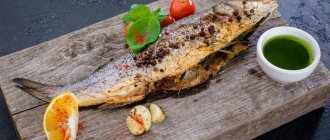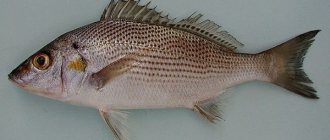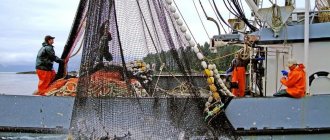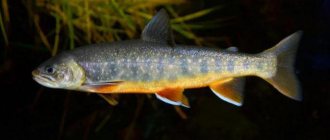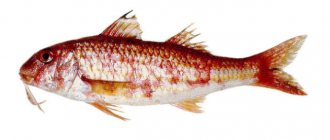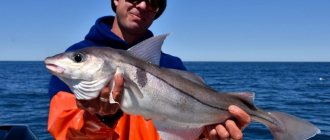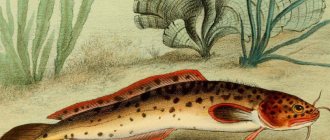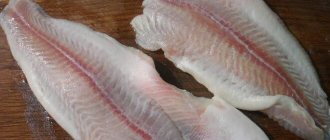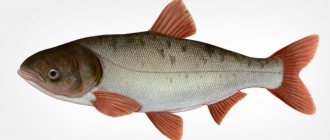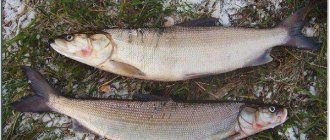Fish of the Far East: which families are of commercial importance
This is a region washed by the waters of the Pacific Basin. The world's largest stocks of commercial salmon and cod fish are concentrated here. The economic fishing zone affects the adjacent Pacific Seas (Bering, Japan and Okhotsk).
Many salmon species of the Far East are migratory, periodically migrating to rivers and lakes, where they can also be caught.
The names of fish in the Far East are primarily associated with salmonids, such as chum salmon, trout, salmon and others. And it is not surprising, since these species are considered to be the elite of the fishing industry.
Below are descriptions and photos of fish from the Far East that are of commercial importance. The complete list of aquatic organisms in this region is too huge and includes more than 2,000 thousand species. In addition to representatives of the ichthyofauna, this includes invertebrates and mammals (seals, fur seals and others).
Some representatives of fish living in Siberia and the Far East
Grayling
This fish belongs to the salmon family. It is one of the most popular species found in the rivers of the North. The greatest distribution of this species is found in the rivers of Siberia. Grayling gives the greatest preference to clean waters; it also lives in cold rivers and lakes.
The most common weight of grayling caught does not exceed one kilogram, but individuals of about three kilograms can also be caught. The record weight of this fish was 6.8 kg.
Grayling feeds on insects (flies, midges, grasshoppers and others), algae, mollusks, and larvae. He loves to eat any caviar he finds. This species is considered omnivorous.
It is better to catch it on rifts, near huge stones or immediately after them, as well as on rapids. Fishing is done with a fishing rod or spinning rod. Often the fishing process is carried out using a fly. In cases where you fish with spinners or spoons, you need to take a light type of bait, but if the grayling is large, then it can bite on a heavy bait.
Muksun
One of the most valuable northern commercial fish, it belongs to the whitefish family. It can be found in almost any major Siberian river. This individual is valued for its taste, nutritional value and the huge presence of nutrient substances.
The fish can reach 75 cm in length. The most common weight is about 1-2 kilograms. But you can come across 6-7 kg, in rare cases you can meet 12 kg. Fishermen consider a caught fish weighing three kg to be a very large catch. In some regions, fishing for muksun is prohibited. In places where there is no ban, fishing is done with nets, but it is possible to catch this fish with a fly if all kinds of bait are available.
Chir
This fish is related to whitefish.
The largest numbers are found in the Ob and Yenisei rivers. The fish loves semi-fresh or fresh waters; it can be found in Kamchatka. Usually you can catch whitefish no more than half a meter long and weighing up to three kg. The record catch is a fish weighing almost 11 kg and 84 cm long.
Fishing is done with nets, and this individual also bites well on a spinning rod or fishing rod. The baits are various types of mollusks, larvae, insects; you can catch them with artificial baits.
Ide
Belongs to the carp family. It is widely spread in different countries of Europe and Siberia. The fish is omnivorous. The largest quantities can be found in ponds, rivers and lakes. This species does not like cold waters and mountain rivers.
The ide reaches 55 cm and about three kg. In some waters of Siberia you can find fish weighing about 9 kg. Fishing is carried out using spinning rods and fishing rods using conventional gear and lures. The best time for fishing is when it begins to get dark. For bait, bread, maggots, worms and much more are used.
Nelma
It belongs to the whitefish and is considered one of the largest representatives of this genus. The most common habitat is river basins in the Arctic Ocean and river expanses of Siberia.
The average weight category of this aquatic inhabitant is about 10 kilograms, and the maximum weight is 50 kilograms. This species is considered to have the best taste among the inhabitants of Siberian rivers.
In many areas of Siberia, fishing for nelma is prohibited. It is almost impossible to catch it with spinning rods; nelma are caught industrially in artels.
Omul
The fish also belongs to the whitefish genus.
The largest number of individuals is found on the largest lake in the country (Baikal). This individual reaches small sizes and weighs no more than eight kg. Mining occurs constantly, regardless of the time of year, from a boat or shore. You can catch it using various types of bait; the bite is especially good on brightly colored and small-sized gear.
Often fish, meat and foam rubber are used as bait. In winter, omul descends to a depth of more than 200 meters, so for catching it is necessary to use a special type of gear.
Pyzhyan
The habitat of the pyzhyan is the Siberian river expanses. The fish reaches a length of about 0.8 m and a weight of up to 5 kg.
Extraction is carried out using nets or cast seines. Amateurs fish with ordinary baits and tackle.
Pyzhyan prefers to eat mollusks, insects and larvae.
Tugun
The fish is found in rivers located in the North. The largest number lives in Lena, Yenisei, Ob and others.
In exceptional cases, a river inhabitant about a meter long and weighing up to 100 kg may be caught.
Fish are caught in summer or spring. The most effective method is seine fishing.
Lenok
Lenok belongs to the salmon family and lives in freshwater waters (rivers, reservoirs). Found in the Far East and Siberia. Most common in riffles and mountain rivers.
The fish is carnivorous and prefers to feed on flies, shellfish, insects and worms. Mining is carried out only with spinning rods. Young fish can be caught with a fly, spinner, spinner, or wobbler.
Taimen
This species of salmon is listed in the Red Book.
In many reservoirs, mining is prohibited. It prefers to live in cold and fresh waters; taimen does not enter the depths of the sea. Individuals up to two meters long and weighing up to 80 kg can be found. Taimen is a predatory fish and should be caught in the same way as other predatory species. It can be caught only under a license or on the condition that the fish will subsequently be released. Caught on wobblers, spinners, spinners and many other tackles designed for spinning rods.
Pike
The entire family of this fish lives throughout Russia. Pike is the most common fish in Russian reservoirs.
In exceptional cases, you can meet individuals up to 35 kg and up to several meters long. The best time for pike fishing is autumn and spring.
At this time of year, pike are very hungry. You can fish with different baits if you use a spinning rod.
Dace
Dace is often found in various lakes and rivers with flowing and clean waters.
They catch fish on ordinary-type fishing rods with the following baits: maggots, worms, bread, bloodworms and porridge.
Burbot
Burbot is a cod-like fish and is found in freshwater waters. This species is most widespread in the Arctic Ocean, as well as in all taiga zones.
In ordinary cases, its weight cannot be more than one kg, but sometimes individuals weighing about 25 kilograms are found.
It is better to fish for burbot in the winter or early spring. It is preferable to fish with a fishing rod using live bait.
Chukuchan ordinary
This species is the only representative of the Chukuchanov family that can be found in rivers and reservoirs of Siberia.
Fishing is usually done with spinning rods using different types of gear. Chukuchan is a predatory fish, so when fishing it is better to use the following bait: shellfish, worms, insects and larvae.
Chebak
Chebak is a carp and is widespread in Siberia and the Urals. The fish is not large, but there are individuals weighing about three kg.
Chebak is an omnivorous fish, which is why it can be caught using bait of plant and animal origin.
During amateur fishing, fishing is done with a fishing rod using different types of bait.
Red fish of the Far East
This term is usually used to refer to delicious representatives of the sturgeon family. However, in common parlance it is also applied to some species of salmon living in the Far East. Fishes of this group are distinguished by the characteristic color of their meat, which can be pink or red-pink. However, not all inhabitants of the depths have this trait.
Among the fish of the Far East, the name “red” is used in relation to the following species:
Initially it was used to mean the quality of the meat, not its color, and was applied only to sturgeon. However, later the name was assigned to salmonids. In the Far East, fish belonging to this family are a key fishery object.
Pink salmon
Pink salmon (lat. Oncorhynchus gorbuscha) is the most common species of Pacific salmon and is classified as the most important commercial fish. Among the representatives of its genus, this fish has the smallest size (on average 44-49 cm). Some individuals grow up to 68 cm.
The characteristic features of pink salmon are:
- small scales;
- presence of an adipose fin;
- short dorsal fin (less than 17 rays);
- changing color (at sea - silver, during spawning - brownish with a black head and white belly).
Pink salmon is an anadromous species and migrates to rivers during the breeding season. Before the first spawning, the body of this fish undergoes significant changes, especially pronounced in males. Juvenile pink salmon look the same and have a silvery, short body with a long mouth containing small teeth. In the river, the body is flattened laterally, and the jaws are significantly lengthened. In males, a hump is formed on the back, which gave rise to the name of the species, and the mouth becomes similar to a bird’s beak.
Red salmon
Sockeye salmon (Oncorhynchus nerka) is known for the excellent taste of its meat. However, in the Russian Far East this species is found much less frequently than chum salmon and coho salmon.
Popularly, sockeye salmon is otherwise called red fish due to the corresponding color of its body. However, Oncorhynchus nerka acquires such an appearance only during the spawning period, when it migrates to rivers. This time is accompanied by the following morphological changes:
- roughening of the skin, as a result of which individual scales become indistinguishable and the surface appears smooth;
- change in color (the head becomes olive green and the body becomes bright red);
- the appearance of large teeth;
- change in the shape of the jaws in males (lengthening and formation of a bend in the shape of a beak).
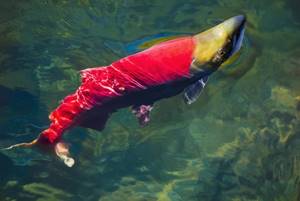
Oceanic sockeye salmon has an elongated body, cylindrical in cross-section. The dorsal side of these fish is dark gray, and the rest of the integument is painted silver-white. The scales are small, but clearly visible.
A distinctive feature of sockeye salmon from other representatives of the genus Oncorhynchus is the special color of the meat (bright red, not pink).
Chinook
Among the salmon fish of the Far East, chinook salmon (Oncorhynchus tshawytscha) is the fattest (up to 13.5%). Individuals of this species are quite large (average length - 90 cm, weight - up to 25 kg). The body of the Chinook salmon is very massive, shaped like a torpedo.
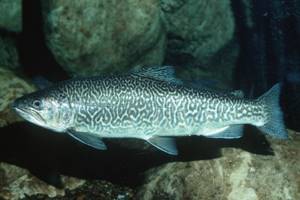
The color of the adult fish before spawning is silvery with a dark back covered with transverse stripes. Before breeding, sockeye salmon acquires a nuptial plumage. At the same time, the scales on the back become almost black, and on the sides and belly they acquire a reddish-brown tint. Unlike sockeye salmon, pink salmon and chum salmon, Chinook salmon practically does not undergo changes in body proportions associated with the onset of spawning. In some individuals, teeth may appear, and in males, jaws may become bent.
Fish production in the Far Eastern basin is reaching last year's level
Since the beginning of the year, almost 1.4 million tons of fish have been caught in the Far Eastern fishery basin, which is 13.6 tons less than last year’s catch for the same period, the press service of Rosrybolovstvo reported.
The dynamics of the catch are monitored by the department at weekly operational meetings and at fishing headquarters. “Russian fishermen are moving with minimal lag, the Far East is catching up in terms of indicators, and the Northern Basin is strengthening its position,” the report says.
Reportedly, pollock fishing in the Far Eastern Federal District increased (compared to the same period last year) by 23.31 thousand.
tons, exceeding 1 million tons. The cod fishery produced almost 55.8 thousand tons (an increase of 5 thousand tons, 3.7%).
In the Northern Basin, the catch reached 315 thousand tons with an increase from last year’s volume on this date of 57.7 thousand tons due to capelin production in the amount of 65.93 thousand tons. The cod catch amounted to 181 thousand tons, which is less than last year’s level by 4.3 thousand tons. The haddock catch decreased by 10 thousand tons, to 40.9 thousand tons.
In general, more than 2.08 million tons of aquatic biological resources have been produced in the Russian Federation since the beginning of the year (0.1% decline).
The spawning process of salmon - some surprising facts
Salmon spawning has long been considered a very mysterious process. Rather, it’s not even the spawning procedure itself, but what precedes it and what happens after it ends.
It is also interesting that there are no exact and clear answers to many issues that relate to salmon spawning. And there are a large number of theories related to the spawning of this fish.
Since salmon are not averse to living in the sea, they try to move to rivers to spawn, grouping in schools. This happens at the end of May or beginning of June. They swim as close to the surface of the water as possible, their speed of movement is so high that sometimes they can create quite strong waves. There are practically no fish that can compete with salmon in speed: in moments of danger or hunting for prey, the speed of this fish can be 40 miles per hour.
Salmon have a very powerful tail, which allows it to swim so quickly and even overcome obstacles such as small waterfalls.
As for the influence of weather conditions on salmon spawning, this is practically no obstacle. Researchers have noticed that there are cases of spawning in all four seasons.
Salmon spawning occurs in fast rivers with clear water and a rocky bottom. The depth at which spawning occurs can vary from 35 centimeters to 1 meter. But salmon is such an amazing fish that in some places they even have to run aground and this doesn’t bother them at all. In order to spawn in such places, salmon must lie on its side and only then the water completely covers the fish.
Female salmon, thanks to their powerful caudal fin, dig a hole at the bottom of the river. This process is quite long and labor-intensive, and the female takes it very seriously. At these moments she is very aggressive. This condition is due to the fact that each of the females wants to take the safest place for herself, because the success of spawning largely depends on what place the female chooses for spawning. All this takes the female salmon a lot of energy and strength.
At this time, a fierce struggle for fertilization of eggs occurs between males. The fight for this takes place at the moment of spawning, and the male who will be in the center at the moment of milk release is considered the strongest. And the rest will be on the sides. And this factor determines what kind of offspring this species will have. A dominant male will give birth to stronger and more resilient offspring.
In this article you will learn about the spawning process of crucian carp.
Then thousands of eggs are laid in the hole that was prepared in advance. The female salmon fills the hole until a tubercle forms. The entire process can take anywhere from several days to a week. The female remains to guard the nest, but not for long.
Since she is exhausted after all the processes, she most often dies. Do you think that males rush to the sea immediately after the female spawns eggs? But no.
Salmon after spawning, having also lost a lot of strength, not all survive; sometimes they give themselves completely to the flow of the river. According to scientists, some salmon spawn repeatedly. Very rarely do you come across specimens that are already going to spawn for the third or even fourth time.
Salmon that die during spawning are easy prey for various organisms and insects living in rivers. And they, in turn, become a food supply for the fry, which after 2-3 months break the shell of the eggs. After a short period of time, when their body gets stronger, the fry go to the seas and oceans. So that in a few years, when they can go to spawn, they will return to rivers and streams.
Why don't salmon stay in rivers straight away? Everything is very simple. Since the survival rate of salmon offspring is high, and the food supply in the rivers for such fish is insufficient, they would have to eat each other. Well, in the open sea, the amount of food is much higher, which allows small salmon to grow stronger.
There are several theories why salmon die after spawning:
- Those salmon that eat little when they go to spawn die from exhaustion.
- Since salmon get used to life in salty sea water, they cannot stay in fresh water for a long time.
- There is a theory about the biological cycle of salmon, that is, the fish lives as long as it is supposed to.
- And another theory is that all of the above factors influence the death of salmon after spawning.
To summarize, we can say that the spawning process of salmon is very interesting and mysterious. It is difficult to understand and comprehend the entire spawning process in this species.
The high survival rate of the fry allows you to maintain the salmon population, unpretentiousness to weather conditions and temperatures contributes to the production of offspring at any time of the year.
In this video you will see how salmon go to spawn.
And this article will tell you a lot of interesting things about the spawning of bream.
On our website https://lovisam.net there is still a lot of interesting and useful information about catching different types of fish.
We recommend checking out: https://lovisam.net
Salmon
Atlantic salmon, otherwise called salmon (lat. Salmo salar) is a very valuable commercial fish, the meat of which has high taste and is considered a delicacy. These are quite large animals with a length of up to 150 cm and a weight of up to 43 kg. Salmon is an anadromous species and can form freshwater forms, settling in lakes.
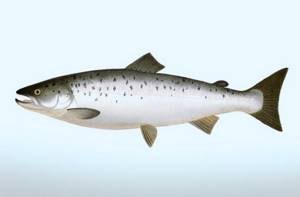
The body of this fish is covered with bright silver scales, which on the dorsal side acquire a bluish tint. Above the lateral line, the color is complemented by several dark spots. The belly is light.
Changes before spawning are expressed in the darkening of the scales and the appearance of red and orange markings on the head and sides. In males, the mating plumage is much more pronounced. In addition to the change in color, they undergo a characteristic morphological restructuring of the jaws (elongation and hook-shaped curvature).
Coho salmon
Coho salmon (Oncorhynchus kisutch) is a very valuable commercial fish of the Far East, however, its population is very small. Since this species is bottom-dwelling, catching is carried out using trawls and fixed seines. The distribution range of coho salmon includes the territories of the Bering, Japan and Okhotsk seas. A small number of coho salmon live in the area of eastern Sakhalin and Hokkaido.
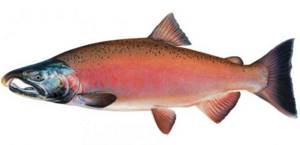
Theragra chalcogramma is a very large fish. Some individuals grow up to 108 cm and gain a weight of about 14 kg. However, the average dimensions for this species are much more modest (length 60-80 cm, weight - 3-3.5 kg).
Coho salmon have a silvery body, with a dark back covered with dark spots that also extend to the caudal fin. During the spawning period, the color changes to dark crimson.
Sima (Oncorhynchus masou) is the oldest representative of the Pacific salmon. This large fish can reach a length of 63 cm and weigh about 6 kg. Outwardly, it resembles coho salmon or chinook salmon, but has larger dark spots on its body.
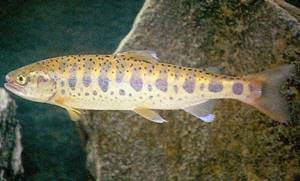
During spawning, the Sim acquires a very bright color: the scales become olive and are covered with crimson and red stripes running in the transverse direction.
Minimum allowed fish sizes
| Type of aquatic biological resources | Fishing size, not less (in cm) |
| Toothless | 10 |
| Outrigger | 25 |
| Verkhoglyad | 60 |
| Loaches (anadromous form) in water bodies of fishery importance in the Kamchatka Territory | 26 |
| Loaches (anadromous form) in water bodies of fishery importance in Primorsky Krai | 45 |
| Loaches (anadromous form) in rivers flowing into the Sea of Okhotsk within the North Sea of Okhotsk subzone (within the boundaries of the Magadan region) | 32 |
| Loaches (anadromous form) in water bodies of fishery importance in the Khabarovsk Territory | 35 |
| Loaches (anadromous form) in water bodies of fishery importance in the Sakhalin region | 20 |
| Loaches (anadromous form) in rivers flowing into the Sea of Okhotsk within the Western Kamchatka subzone (within the boundaries of the Magadan region) | 36 |
| Loaches (freshwater residential form) in water bodies of fishery importance in the Sakhalin region | 11 |
| Loaches (freshwater residential form) in water bodies of fishery importance in Primorsky Krai | 15 |
| Loaches (freshwater residential form) in other water bodies of fishery importance | |
| Asp | 25 |
| Snakehead | 40 |
| Far Eastern flounders | 21 |
| Crucian carp in the Amur River basin and other water bodies of fishery importance in the Khabarovsk Territory and the Jewish Autonomous Region | 20 |
| Crucian carp in closed lakes of the Khabarovsk Territory and the Jewish Autonomous Region, not connected by channels with the Amur River and its channels | 18 |
| Crucian carp in the Ust-Kamchatsky and Bystrinsky districts of the Kamchatka Territory | 18 |
| Crucian carp in other areas | 16 |
| Horse | 20 |
| Hairy quadrangular crab | 8 |
| Kamchatka crab | 13 |
| Spiny crab | 10 |
| Hairy crab | 5 |
| Crab blue | 13 |
| Mongolian redfin | 30 |
| Far Eastern rudd-ugai | 15 |
| Grass shrimp | 6 |
| Angled tail shrimp | 6 |
| Corbicula | 2,2 |
| Lenok | 45 |
| Bream | 35 |
| Mussels | 10 |
| Pollock | 30 |
| Muksun | 39 |
| Navaga in the estuaries of Avacha Bay | 17 |
| Navaga in other areas | 19 |
| Burbot | 45 |
| Halibut | 62 |
| Perlovitsa | 7 |
| Cancers | 8 |
| vendace | 24 |
| Carp in the Amur River basin within the borders of the Khabarovsk Territory, Jewish Autonomous Region | 42 |
| Carp in other areas | 35 |
| Pacific herring in the Western Sakhalin subzone north of Cape Lamanon, in the Primorye subzone north of Cape Zolotoy | 19 |
| Pacific herring in the West Bering Sea zone | 25 |
| Pacific herring in water bodies of fishery importance in the Kamchatka Territory | 15 |
| Pacific herring in water bodies of fishery importance in the Sakhalin region | 16 |
| Pacific herring in the Primorye subzones south of Cape Zolotoy | 23 |
| Whitefish in the Amur River basin | 35 |
| Whitefish in water bodies of fishery importance in the Chukotka Autonomous Okrug | 32 |
| Freshwater catfish | 50 |
| Taimen | 70 |
| Terpugi in the northern part of the Sea of Okhotsk, adjacent to the Magadan region | 18 |
| Terpugi in other areas | 25 |
| Silver carps | 60 |
| Far Eastern sea cucumber | 100 |
| _______________ Based on the mass of the skin-muscle sac in grams. | |
| Cod | 40 |
| Trumpeters | 7 |
| Oysters | 12 |
| Grayling in the Amur River basin and in water bodies of fishery importance in the Jewish Autonomous Region | 18 |
| Grayling in water bodies of fishery importance in the Khabarovsk Territory (except for the Amur River) | 20 |
| Grayling in other areas | 25 |
| Chir | 40 |
| Baby Shrims | 9 |
| Pike in water bodies of fishery importance in the Kamchatka Territory and the Chukotka Autonomous Okrug | 40 |
| Pike in other areas | 50 |
We recommend: How does atmospheric pressure affect the bite and activity of fish?
Commercial size is determined in fresh form : in fish - by measuring the length from the top of the snout (with the mouth closed) to the base of the middle rays of the caudal fin; in shrimps and shrimps - by measuring the distance from the posterior edge of the eye orbit to the end of the telson; in crabs - by measuring along the greatest width of the shell without taking into account the spines; for whelks and scallops - by measuring the greatest height of the shell; in other bivalves - according to the longest shell length.
cod
Among the fish species of the cod family living in the Far East, the following are of greatest commercial importance:
- pollock (Theragra chalcogramma);
- Pacific cod (Gadus macrocephalus);
- Far Eastern navaga (Eleginus gracilis).
Pollock is a large fish with an oblong body, the maximum length of which is 91 cm and weight 5 kg. This species prefers the cold waters of the Pacific Ocean, living at a depth of 200-300 meters, but in some cases dropping to 700 and below.
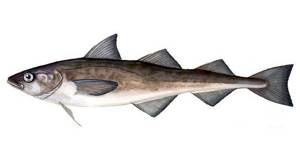
The color of pollock is spotted, with the exception of the belly, which is a solid olive green color. The scales darken towards the upper side of the body. The characteristic features of Theragra chalcogramma are the presence of three dorsal fins and a barbel on the chin.
Pacific cod is large in size (length up to 115 cm, weight up to 18 kg). However, in fishing areas smaller individuals (50-80 cm) predominate. Cod has a long body that tapers to a tail and is covered with small brown scales. Above the lateral line, the color is complemented by a large number of small dark spots.

Navaga is a fairly popular sea fish of the Far East, also known locally as vakhnya. This type of cod has a relatively small size (maximum length - 55 cm, average - 30-35). Far Eastern navaga is valued for the high gastronomic qualities of its meat and its nutritional value. However, its extraction is very difficult.
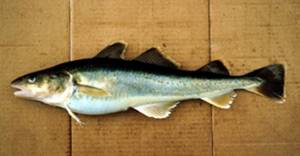
Northern fish
Northern fish lives in large Siberian rivers. It can be found in the Ob, Lena, Irtysh, Yenisei and smaller river systems. Production on an industrial scale is carried out in the waters of the Arctic Ocean.
Fish of the northern seas and rivers and its characteristics
In the waters of northern rivers and seas you can find the following species:
- salmon;
- cod;
- sturgeon;
- whitefish;
- smelt
Some of them live in fresh water, others prefer the deep sea. Their meat has a high taste; dishes made from such fish are not only tasty, but also healthy.
The excellent taste is due to the clean water in which fish from the northern seas live, because they live in their natural environment. When preparing, quick freezing technology is used, which preserves all the beneficial substances. Some of them are subject to sport fishing, but the vast majority of the inhabitants of reservoirs are caught during industrial fishing.
Names of popular northern fish with photos
Fish from Siberia is valued for its taste. The list of species is large, but most often you can buy cod, salmon, vendace and omul in stores. Delicious dishes are prepared from burbot, sterlet, taimen, but these are rare fish species.
Blue whiting, haddock, pollock, and hake are available to a wide range of consumers. Nelma and muksun are considered very expensive species. The latter can be called a relative of salmon, but muksun meat does not contain mineral salts. But it contains bromine, copper and other useful trace elements.
Muksun is suitable for those people who suffer from kidney diseases.
Nelma is in demand for its tender meat; it contains molybdenum, fluorine and other useful substances. It is used in dietary nutrition, but has a high cost, so not everyone can include it in their daily diet.
Whitefish is distinguished by fatty and nutritious meat, it has a delicate taste. It contains a lot of vitamin A, so whitefish dishes will help strengthen bones and have a beneficial effect on vision.
Omul lives in Baikal, but it is also caught in the Yenisei. It is believed that omul from the river has a more pronounced taste. Its meat is tender and fatty, so you don’t have to add oil when preparing dishes. Cheer is little known among buyers.
This fish in Siberia lives in places where large rivers flow into the Arctic Ocean, but is also found in lakes with fresh water. Chir belongs to the whitefish family.
There are many fishing spots; those fishermen who are planning to go fishing need to know the names of the largest ones.
Pyzhyan has good taste and is called Siberian whitefish. Its weight reaches 5 kg, it can be up to 80 cm in length. Pyzhyan is a commercial fish, but it can also be caught by amateurs. Tugun belongs to the whitefish, it is also called Sosvinskaya herring. The meat is fatty and tender, with a slight hint of cucumber. Any fish from the northern seas will be good for health.
Distinctive features
A distinctive feature of fish is its high content of microelements, such as phosphorus and iodine. The meat is fatty and contains a lot of Omega-3. This polyunsaturated fat is essential for the nutrition of people of all ages. Fish from northern rivers is easy to cook. There are few bones in it, so little waste is generated.
Commercial value
Commercial fish are those species of fish in which the state is interested in catching. Enterprises put up their catch for sale, and part of it goes for processing. Medicines and fertilizers are made from raw materials, and industrial fats are produced.
The volume of production is set by the state. They catch fish that live at shallow depths. Fishing ships go to the habitats of muksun and salmon. Some salmon live in the Ob and Irtysh, so fishing is carried out not only in the Arctic Ocean, but also in the river systems of Russia.
Northern fish is different in that its meat contains a large amount of fat, but its composition is not similar to the fat of the inhabitants of the southern seas. Fatty acids are unsaturated, so at low temperatures they do not crystallize, but remain in a form that retains nutrients as much as possible.
Omega-3 and large amounts of protein (much higher than that found in meat) are the hallmarks of the inhabitants of northern waters. Eating such fish reduces the likelihood of rheumatoid arthritis, heart and vascular diseases by 50%. This is an effective anti-inflammatory drug that has a beneficial effect on the brain and helps prolong life.
Culinary features
Northern fish is most often associated with stroganina, but many dishes can be prepared from it. Dried fish has a rich taste; muksun is suitable for this purpose, but you can cook omul.
Stroganina, which is frozen meat cut into shavings, is made from muksun. You can also take whitefish or omul. There are no opisthorchid larvae in muksun, so you can eat it without fear for your health.
Whitefish can be baked with vegetables and sauces, and nelma is best suited for frying. With this method of cooking, it reveals its taste. Chira is fried and baked. Omul is used in salted, smoked forms, and also as planed meat. Tugun is smoked and consumed salted.
Northern sea fish can be salted; steaks are also made from it, and they are fried without adding oil. The carcasses are smoked, and the heads are made into fish soup.
Stroganina is often made in the north, but housewives should know that they should not use meat that has been frozen and thawed several times. Meat for stroganina is stored in ice and must be glazed.
The fillet is used to make sugudai (a dish made from raw fish); for this purpose it is best to buy muksun. It can be eaten lightly salted; for this, muksun is placed in a container with salting for 9 hours. The result is tender meat that melts in your mouth.
Nelma belongs to the whitefish family, but is an endangered species, so its fishing is prohibited in the south of Siberia. In the north it is mined industrially. They eat nelma lightly salted and make stroganina from it.
Flounder
From representatives of this family in the Far East the following are obtained:
- 3 types of flounder (white-bellied, yellow-bellied and yellowfin);
- Pacific halibut;
- black halibut.
White-bellied flounder (Lepidopsetta bilineata) is a bottom-dwelling sea fish with a fleshy body 27-43 cm long. The name of the species corresponds to the color of the lower part of the fish. The upper side of the body is brown or sandy in color. A characteristic feature of the white-bellied flounder is the special structure of the lateral line, which has an arched bend and a branch directed towards the back.
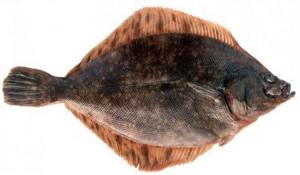
Yellow-bellied flounder (Pleuronectes quadrituberculatus) is a fairly large species, growing up to 60 cm in length. This fish has a wide body covered with smooth scales. The underside of the flounder is lemon yellow, hence the name, while the upper (aka left) part of the body is brownish brown.
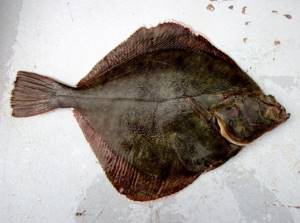
Yellowfin flounder (Limanda aspera) is the most common representative of its genus. It is this species that forms the basis of large concentrations of flounder fish in the Far East. Limanda aspera has a wide body up to 47 cm long. The color of the upper side of the fish adapts to the color scheme of the bottom, and the belly is light. The name of the species is due to the corresponding (yellow) color of the fins.
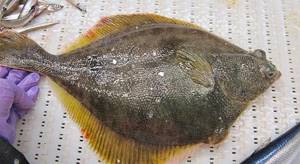
Pacific halibut (Hippoglossus stenolepis) is one of the largest representatives of flounder. The record length of an individual of this species was 470 cm. The fish has an elongated flat body, the eyes are on the right side. The body color is uniform gray or dark brown.
Black halibut (Reinhardtius hippoglossoides) is much smaller than its white relative (length 120 cm, weight 15 kg). Its body has a uniform color, corresponding to its name. The eyes of this fish are located on the right side. A characteristic feature of black halibut is its high fat content (about 10%), which is important in cooking.
Amur fish included in the Red Book
Currently, eight species of fish are classified as rare and endangered. Fishing for these fish is completely prohibited.
Amur sturgeon
Particularly valuable large freshwater fish of the sturgeon family. It reaches a maximum length of 3 m and weighs more than 200 kg. Most often found with a length of 90–170 cm and a weight of 6–40 kg. Before a significant decline in numbers, the species lived throughout the Amur basin. Semi-migratory fish. The sturgeon winters in the riverbed, in deep places. In May, it begins to migrate upstream to spawning grounds. Spawning takes place in June-July. Adults feed on invertebrates (shrimp, larvae, mollusks) and small fish. The population in the Lower Amur and the Amur Estuary, where up to 90% of all sturgeons live, is about 300 thousand individuals. The most serious damage to the population is caused by poaching.
Kaluga
A giant, especially valuable ancient fish, also belonging to the sturgeon family. This is a real champion among river inhabitants: the maximum recorded length is 5.6 m, the weight can reach 1 ton. In the Upper Amur, fish with a length of 150–200 cm and a weight of 50–150 kg are common. The habitat is similar to that of the Amur sturgeon - the entire Amur basin, including large tributaries. The difference is that to feed, kaluga go to the coastal waters of the Sea of Okhotsk, where they spend several years. Eats fish. In the absence of sufficient food, it can eat its own young. Life expectancy is about 40–50 years. The number is limited by the late onset of puberty and poaching.
Yellowcheek
Large predatory fish from the carp family. It grows up to 2 m in length, weight – 35–40 kg. The endemic species lives in the middle and lower reaches of the Amur and its large tributaries. Fish is the yellow-cheek's favorite food. Spawns in riverbeds and wide channels with fast currents in the second half of June. After spawning, it goes to floodplain reservoirs to feed and remains there until autumn. It goes out into the main channel of the Amur River and large tributaries to spend the winter. The yellow-cheeked fish is a cautious fish and rarely bites on artificial baits. Thus, amateur sport fishing does not threaten its numbers. The main threat is poaching with nets.
Small-scaled yellowfin
The only representative of the yellowfin genus. It grows up to 56 cm and weighs 1.7 kg. It begins to spawn at the age of 4–5 years, annually on the Amur at the end of June – July. It feeds on aquatic vegetation and detritus, mainly water moss.
The range includes the beds of lowland rivers and large lakes in the Amur basin. Prefers coastal overgrown zone. In summer it stays on floods and enters the lower reaches of tributaries; in the fall it goes to the riverbed for the winter.
The number is limited by natural (hydrological) factors.
Black bream
Another large representative of the carp family. The appearance is characteristic of the species - the body is flat on the sides, a small head, a back with a high arch. The difference is the black color on the back and fins, dark sides and belly. The fish lives up to 10 years, in favorable conditions it grows up to 60 cm in length and up to 3 kg in weight. Fish have a varied diet, but plant foods predominate. Lives in the southern part of the Amur basin. Spends the warm season in floodplain lakes and channels, winters in the Amur riverbed. Spawns in July. The number is limited only by natural factors.
Black cupid
Freshwater fish from the carp family. Black carp has a wide head and an elongated dark body covered with large scales. Reaches 1 m or more in length and weighs 16 kg. Life expectancy can exceed 13 years. The area is the middle and lower reaches of the Amur and its tributaries. Black carp feed on mollusks and insect larvae. It spends the summer in the channels, and for the winter it goes out into the main channel. It spawns in the second half of June during the period of high water. There are no exact data on the size of the black carp population - only single individuals are found.
The number is quite stable, the main limiting factor is the small area of spawning grounds. There is no threat to the survival of the species, since its number does not decrease with continued fishing.
Som Soldatova
A predatory scaleless fish from the catfish family. An elongated, powerful body with a large head and strong jaws - in terms of size and weight, Soldatov’s catfish confidently falls into the “champion category”. The fish can grow up to 4 m and weigh up to 250 kg. Life expectancy is 18–20 years. It lives in the middle and lower reaches of the Amur. It feeds on fish, but does not disdain waterfowl and rodents and snakes that have fallen into the water. Spends the winter hibernating in deep pools, with virtually no food. In April, without waiting for ice drift, it begins an active lifestyle. From the end of June to mid-July, it rises from the bottom to spawn in vegetation flooded with water.
In recent years, fish have often been found on the Lower Amur, river. Ussuri and lake Hanka. The number is limited mainly by natural factors.
Chinese grouper (auha)
Large freshwater predatory fish of bright color. It has a massive body, large head and strong jaws. Grows up to 70 cm in length. An adult weighs more than 8 kg. Life expectancy is 13 years. Eats fish. The habitat includes the middle and lower reaches of the Amur, its tributaries and floodplain lakes with warm water. Spawns in June-July in the middle reaches. Overwinters in the main channel, hibernating.
In recent years, the number of aukhi in the Amur basin has increased. Common species in bycatch. There is no threat to the survival of the species, since its numbers are growing with continued fishing. It is limited only by natural factors.
Herrings
Pacific herring (Clupea palasi) occupies a special place in the fisheries of the Far East. Populations of this fish live in the coastal zone of Sakhalin Island. The catch is carried out twice a year:
- in autumn (spawning form);
- in late autumn and winter (fatty herring).
Clupea palasi is a medium-sized fish, growing up to 30-40 cm. However, some migratory individuals can reach a length of up to 75 cm. The body of the herring is flattened laterally and covered with silvery scales of medium or large size. The back of the fish is dark and has a bluish tint. There is only one fin on it.
Sports and recreational fishing
Grayling
Freshwater salmon, 5 species are found in the Amur basin: Amur, Lower Amur, Baikalolensky, Bureinsky, yellow-spotted. An agile and lively fish with a large dorsal fin, similar to a sail. It lives in fast mountain rivers - grayling easily copes with strong currents due to its elongated body shape. It feeds on larvae, insects, and eggs of other fish. The length of the fish is about 30 cm, weight is 250–300 g, but larger individuals can also be found.

A beautiful fin and a special body structure help grayling overcome the current
Grayling is an object of sport and recreational fishing. Grayling fishing is carried out using spinning rods, fly fishing tackle and fishing rods.
Lenok
In the Amur there are two species: sharp-snouted and blunt-snouted. Most often, the size of the sharp-snouted lenok is about 40 cm, and the weight is up to 2.5–3 kg. The blunt-nosed fenok is a third larger. The fish has an elongated, powerful body. Lenok is unpretentious in food: it eats larvae, insects, worms, mollusks, juveniles, frogs and even small rodents. In the summer it inhabits the main channel of the river, and in the winter it goes into the pools of large tributaries of the Amur. Lenok can cover a distance of 200–300 km.
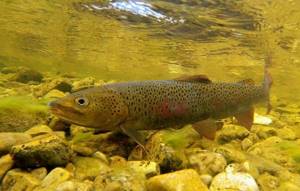
Lenok goes to spawn
The main risks for the population: poaching, industrial development of the basin, construction of a hydroelectric power station.
Taimen
The largest representative of the salmon family. Symbol of Siberia and the Far East. A fast and powerful predator lives in fresh, clean, cold water and feeds on fish. Distributed throughout the Amur basin. In the spring it chooses cold mountain rivers, and in the fall it migrates to the Amur and its large tributaries. During migration, distances cover more than 300 km. The usual size of an adult is 60–70 cm, while there are specimens 1–1.5 m long and weighing up to 80 kg. Taimen lives up to 30 years and grows all the time.
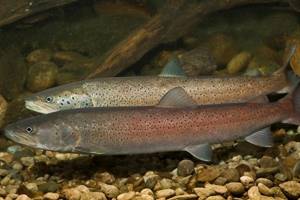
Taimen is one of the largest and heaviest fish of the Amur
In the past it was a commercial species. Poachers and deterioration of water quality associated with human activities pose a great threat to the species.
Terpugidae
The main Far Eastern representative of this family is the southern greenling (Pleurogrammus azonus). This fish lives near Sakhalin Island and is a very valuable fishery object.
Pleurogrammus azonus has an elongated body, slightly flattened on the sides. Its average size is 22-35 cm, and the maximum is 65 cm. Small scales cover the entire body of the fish, except for the snout. A characteristic feature of this species is the presence of 5 lateral lines on each side.
The color of the southern greenling depends on age. In juveniles it is greenish-blue, and in immature fish it is gray. Fully formed individuals, ready for reproduction, are dark brown in color with a white belly and a brown pattern on the upper side.
